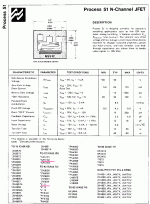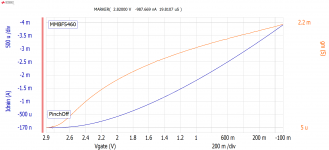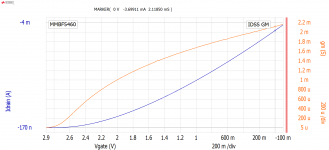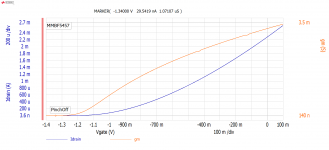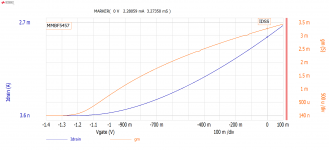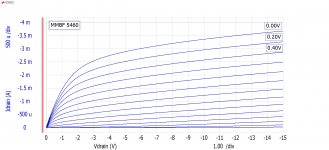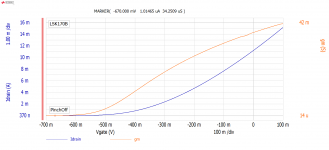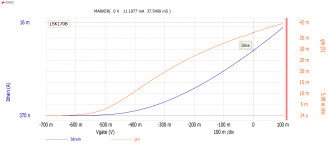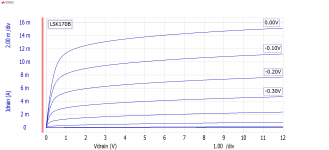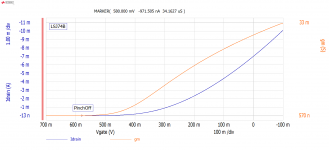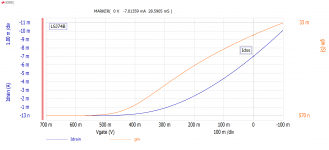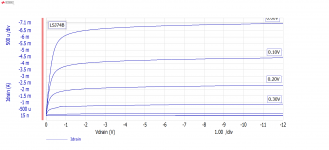> PF5102’s. They are what looks like a different IDSS range of the J111 family of N JFET’s.
They both derive from "Process 51". Which is a mask (shown) and a general "cooking" schedule. The results vary from 0.5V to 9V, 5mA to 170mA, not tightly controllable. From that mixed-lot they sort-out to meet the several part numbers.
http://mirror.thelifeofkenneth.com/lib/electronics_archive/NatSemiFetDatabook1977_text.pdf PDF page 51
They both derive from "Process 51". Which is a mask (shown) and a general "cooking" schedule. The results vary from 0.5V to 9V, 5mA to 170mA, not tightly controllable. From that mixed-lot they sort-out to meet the several part numbers.
http://mirror.thelifeofkenneth.com/lib/electronics_archive/NatSemiFetDatabook1977_text.pdf PDF page 51
Attachments
Hello,
I am thinking that Process 51 from the 1977 catalog is a lot like the raw chocolate chip cookie dough from Papa Murphy. They turn out much differently depending who is baking them. I prefer them a little chewy not crunchy like a cracker.
Forty-two years later I bet that they are better at the process and controlling the IDSS performance.
Looking at the Id-Vg (step) plots on the Process51 sheets and J111 Datasheets the Vg only is tested up to 5Volts. It looks like that the interest on the data sheets is more in switching than the higher voltage saturated range that would be used for DIYaudio.
The batch of ~200 PF5120 Jfet’s on my bench tests in the 7-9mA IDSS range.
The same specification J113 (except IDSS specification) measures mostly in the 10, 11, 12, to 13mA IDSS range.
Added comment:
I am wondering about the JFET noise specifications. The noise specs are at 1KHz or 100KHz. I am more interested in mV or uV in the 20 to 20KHz range plus 1/f noise. When I go about measuring I will try A weighted, C weighted and not weighted. (Measured in a “typical” preamplifier circuit.)
Thoughts?
Thanks DT
I am thinking that Process 51 from the 1977 catalog is a lot like the raw chocolate chip cookie dough from Papa Murphy. They turn out much differently depending who is baking them. I prefer them a little chewy not crunchy like a cracker.
Forty-two years later I bet that they are better at the process and controlling the IDSS performance.
Looking at the Id-Vg (step) plots on the Process51 sheets and J111 Datasheets the Vg only is tested up to 5Volts. It looks like that the interest on the data sheets is more in switching than the higher voltage saturated range that would be used for DIYaudio.
The batch of ~200 PF5120 Jfet’s on my bench tests in the 7-9mA IDSS range.
The same specification J113 (except IDSS specification) measures mostly in the 10, 11, 12, to 13mA IDSS range.
Added comment:
I am wondering about the JFET noise specifications. The noise specs are at 1KHz or 100KHz. I am more interested in mV or uV in the 20 to 20KHz range plus 1/f noise. When I go about measuring I will try A weighted, C weighted and not weighted. (Measured in a “typical” preamplifier circuit.)
Thoughts?
Thanks DT
Here are some high-Gm Jfets from Onsemi for you to consider. Not all of these have noise charts in the datasheet.
2SK3557
https://www.onsemi.com/pub/Collateral/2SK3557-D.PDF
2SK2394
https://www.onsemi.com/pub/Collateral/EN4839-D.PDF
2SK932
https://www.onsemi.com/pub/Collateral/EN2841-D.PDF
MCH5908 is the dual version of 2SK3557 with no guarantees as to offset.
MCH3914 has less capacitance, lower transconductance:
https://www.onsemi.com/pub/Collateral/ENA1511-D.PDF
From the list here:
ON Semiconductor
This circuit could be used for measuring Jfet noise:
http://www.dicks-website.eu/low_noise_amp_part3/part3.html
2SK3557
https://www.onsemi.com/pub/Collateral/2SK3557-D.PDF
2SK2394
https://www.onsemi.com/pub/Collateral/EN4839-D.PDF
2SK932
https://www.onsemi.com/pub/Collateral/EN2841-D.PDF
MCH5908 is the dual version of 2SK3557 with no guarantees as to offset.
MCH3914 has less capacitance, lower transconductance:
https://www.onsemi.com/pub/Collateral/ENA1511-D.PDF
From the list here:
ON Semiconductor
This circuit could be used for measuring Jfet noise:
http://www.dicks-website.eu/low_noise_amp_part3/part3.html
Last edited:
JFET Saturation?
Hello All,
These tiny little SOT 23 JFETS are a pain. Yes you can pick them up with tweezers, put them into a socket and measure them. Even on a good day solder them by hand. You take them out of the strip, do the measurements, now what do you do with them. How do you label and store them. Did I say pain?
I received some MMBF2457’s and MMBF5460’s from Mouser. The N and P JFET’s do not test equal and opposite at all. Even if the IDSS tested sort of the close, the Pinch Off voltages and Transconductance do not look like they anything like N’s and P’s from the same family.
The MMBF5460’s never really making it into Saturation as a good JFET should.
See the attached plots.
Thanks DT
for JFET noise measurement see ;
https://leachlegacy.ece.gatech.edu/ece6416/f09/JFET_Noise.pdf
Hello All,
These tiny little SOT 23 JFETS are a pain. Yes you can pick them up with tweezers, put them into a socket and measure them. Even on a good day solder them by hand. You take them out of the strip, do the measurements, now what do you do with them. How do you label and store them. Did I say pain?
I received some MMBF2457’s and MMBF5460’s from Mouser. The N and P JFET’s do not test equal and opposite at all. Even if the IDSS tested sort of the close, the Pinch Off voltages and Transconductance do not look like they anything like N’s and P’s from the same family.
The MMBF5460’s never really making it into Saturation as a good JFET should.
See the attached plots.
Thanks DT
for JFET noise measurement see ;
https://leachlegacy.ece.gatech.edu/ece6416/f09/JFET_Noise.pdf
Attachments
Keysight B2912A
That looks to be a wonderful instrument.
I have recently acquired a pair of old Keithley SMUs, the ones with triaxial connectors rather than binding posts or banana sockets, so it is interesting :facepalm: to try to find / build triaxial cables for them in a relatively economical way.
So I was just curious, how did you choose between the Keysight vs a new Keithley?
That looks to be a wonderful instrument.
I have recently acquired a pair of old Keithley SMUs, the ones with triaxial connectors rather than binding posts or banana sockets, so it is interesting :facepalm: to try to find / build triaxial cables for them in a relatively economical way.
So I was just curious, how did you choose between the Keysight vs a new Keithley?
I bought some of the Toshiba SOT-23 size and did some spot checking and quickly hit the issue.
My current thoughts are to use small antistatic pink ziplock type, maybe 2.5x4 or so, and then group them and put into larger proper metalized bags for storage. The pink bags can be folded up and maybe paper clipped further locking in the tiny parts so none escape if a ziplock seam has partially popped.
It is tough to see the little things in the metalized bags and I don't want to put labels on each bag.
The pink bags can be written on directly and are clear enough to see if there is a single grain of pepper in a corner.
It's gonna take a bunch of plastic bags though.
At the moment this seems like the cheapest safe way to store and group them.
My current thoughts are to use small antistatic pink ziplock type, maybe 2.5x4 or so, and then group them and put into larger proper metalized bags for storage. The pink bags can be folded up and maybe paper clipped further locking in the tiny parts so none escape if a ziplock seam has partially popped.
It is tough to see the little things in the metalized bags and I don't want to put labels on each bag.
The pink bags can be written on directly and are clear enough to see if there is a single grain of pepper in a corner.
It's gonna take a bunch of plastic bags though.
At the moment this seems like the cheapest safe way to store and group them.
> You take them out of the strip, do the measurements, now what do you do with them. How do you label and store them ?
Put them in a elelctrostatic zip bag and label with permasnent marker.
I have done thousands. A few others have done hundreds (BJTs).
https://www.diyaudio.com/forums/hea...pioneer-super-linear-circuit.html#post5228115 (post #48)
What's the problem ?
> The N and P JFET’s do not test equal and opposite at all.
No surprise.
The only truely complementary N-P JFET pair is 2SK163 / 2SJ44, as I published at the F5X thread ages ago.
Not even 2SK170/2SJ74 are truely complementary (also published).
> The MMBF5460’s never really making it into Saturation as a good JFET should.
If I use them as followers or "penthodes", I want them to saturate soon.
So it depends on the circuit.
> for JFET noise measurement see
More FET noise measurements (for EUVL)
My version of the G = 1000 low noise measurement amp (for Ikoflexer).
And for other JFET measurements, see :
FET Measurements with Just A DMM
Don't need special equipment.
Cheers,
Patrick
Put them in a elelctrostatic zip bag and label with permasnent marker.
I have done thousands. A few others have done hundreds (BJTs).
https://www.diyaudio.com/forums/hea...pioneer-super-linear-circuit.html#post5228115 (post #48)
What's the problem ?
> The N and P JFET’s do not test equal and opposite at all.
No surprise.
The only truely complementary N-P JFET pair is 2SK163 / 2SJ44, as I published at the F5X thread ages ago.
Not even 2SK170/2SJ74 are truely complementary (also published).
> The MMBF5460’s never really making it into Saturation as a good JFET should.
If I use them as followers or "penthodes", I want them to saturate soon.
So it depends on the circuit.
> for JFET noise measurement see
More FET noise measurements (for EUVL)
My version of the G = 1000 low noise measurement amp (for Ikoflexer).
And for other JFET measurements, see :
FET Measurements with Just A DMM
Don't need special equipment.
Cheers,
Patrick
Mirlo,
I got an invitation to a Keysight hands on all day lunch and learn thing and liked their parameter measuring stuff. I bought a current model O’scope used from Keysight on Ebay. Being a registered owner / user I received excellent user support from Keysight. I bought a 600V power supply, again used from Keysight on Ebay, it failed within a week. I took it to the Roseville Keysight Service Center. They made it good as new under warrantee with a calibration cert to go with it. I will buy from Keysight again because of excellent user support, also excellent quality instruments.
DaveG,
I am thinking of using these little jars. The jars have a 1 inch wide mouth you can reach into with a pair of forceps. The JFET’s are not very ESD sensitive. All those little bags you cannot see into looks crazy.
https://www.uline.com/Product/Detai...ound-Wide-Mouth-Plastic-Jars-1-2-oz-White-Cap
Patrick,
Thank You.
I know that I am retracing old ground. I am processing what I know, including JFET noise. What I do is write a lesson plan and put together a Lab project. Also look at what others have done. Divide the measurement by all the gains, compare to a known noise source and call the results Equivalent input noise. Marshall Leach has good stuff attached above. Texas Instruments has a good tech note attached. Plus you have some good references.
http://www.ti.com/lit/ug/tidu016/tidu016.pdf
Thanks DT
I got an invitation to a Keysight hands on all day lunch and learn thing and liked their parameter measuring stuff. I bought a current model O’scope used from Keysight on Ebay. Being a registered owner / user I received excellent user support from Keysight. I bought a 600V power supply, again used from Keysight on Ebay, it failed within a week. I took it to the Roseville Keysight Service Center. They made it good as new under warrantee with a calibration cert to go with it. I will buy from Keysight again because of excellent user support, also excellent quality instruments.
DaveG,
I am thinking of using these little jars. The jars have a 1 inch wide mouth you can reach into with a pair of forceps. The JFET’s are not very ESD sensitive. All those little bags you cannot see into looks crazy.
https://www.uline.com/Product/Detai...ound-Wide-Mouth-Plastic-Jars-1-2-oz-White-Cap
Patrick,
Thank You.
I know that I am retracing old ground. I am processing what I know, including JFET noise. What I do is write a lesson plan and put together a Lab project. Also look at what others have done. Divide the measurement by all the gains, compare to a known noise source and call the results Equivalent input noise. Marshall Leach has good stuff attached above. Texas Instruments has a good tech note attached. Plus you have some good references.
http://www.ti.com/lit/ug/tidu016/tidu016.pdf
Thanks DT
Last edited:
Found Free Sample Transistors LSK170B and LSJ74B JFETs
Free Sample Transistors
Today I was looking at my copy of Vol. 6 of Linear audio and found free sample LSK170B and LSJ74B JFETs inside the pages.
See the attached plots.
Thanks DT
Free Sample Transistors
Today I was looking at my copy of Vol. 6 of Linear audio and found free sample LSK170B and LSJ74B JFETs inside the pages.
See the attached plots.
Thanks DT
Attachments
Chasing that last pV of noise.
Hello All,
Sitting here thinking about what I know about noise and distortion. Here are a couple of things:
If you average over enough samples noise voltage will go to zero. If you look close enough at your FFT’s you can begin to glimpse harmonics that you can only hear in your dreams.
Noise power is always nonzero. Real world real time noise power, as in watts, will swamp those tiny little harmonics that begin to be visible in your miniscule bin size FFT’s.
Back to JFET noise and measuring vanishing JFET noise. Bottom line we do not want our line level preamplifiers, crossover followers and the like adding any perceptible noise. We could go all in and start probing with our 60dB gain noise probes chasing that last pV of noise. That just may be overkill in terms of, “can I hear it in my Audeze headphones”?
What I am going to do here is assemble a couple of JFET line level circuits, short the inputs then measure noise with a couple of different audio analyzers here on my bench. Next I will attach a couple of the suspect sources that we often use; DAC and or FM tuner…
Thoughts to add anyone?
Thanks DT
Hello All,
Sitting here thinking about what I know about noise and distortion. Here are a couple of things:
If you average over enough samples noise voltage will go to zero. If you look close enough at your FFT’s you can begin to glimpse harmonics that you can only hear in your dreams.
Noise power is always nonzero. Real world real time noise power, as in watts, will swamp those tiny little harmonics that begin to be visible in your miniscule bin size FFT’s.
Back to JFET noise and measuring vanishing JFET noise. Bottom line we do not want our line level preamplifiers, crossover followers and the like adding any perceptible noise. We could go all in and start probing with our 60dB gain noise probes chasing that last pV of noise. That just may be overkill in terms of, “can I hear it in my Audeze headphones”?
What I am going to do here is assemble a couple of JFET line level circuits, short the inputs then measure noise with a couple of different audio analyzers here on my bench. Next I will attach a couple of the suspect sources that we often use; DAC and or FM tuner…
Thoughts to add anyone?
Thanks DT
I do not understand your motivation, other than fun playing with your Keysight.
Which of course is perfectly fine.
If people want to use JFETs as a buffer, then both Nelson and I have published enough information on alternatives to 2SK170s.
They will probably cover all line level, DAC, ... applications.
But not phono- or mic-preamps.
So what is your message your are trying to convey to the readers here ?
Or this thread is not meant to convey any message ?
Patrick
Which of course is perfectly fine.
If people want to use JFETs as a buffer, then both Nelson and I have published enough information on alternatives to 2SK170s.
They will probably cover all line level, DAC, ... applications.
But not phono- or mic-preamps.
So what is your message your are trying to convey to the readers here ?
Or this thread is not meant to convey any message ?
Patrick
Thanks for your efforts.
What I really love to see above all is the intrinsic noise of the JFet's, and the 1/F corner frequency. The contribution of various topologies comes second, because these are under the control of the average DIYers.
Keep up the good work!
PS/Edit: my interest is vinyl
What I really love to see above all is the intrinsic noise of the JFet's, and the 1/F corner frequency. The contribution of various topologies comes second, because these are under the control of the average DIYers.
Keep up the good work!
PS/Edit: my interest is vinyl
> the intrinsic noise of the JFet's, and the 1/F corner frequency
More FET noise measurements (for EUVL)
Measurements Rate SMT Low-Voltage n-JFETs Under Consistent Conditions | Electronic Design
My version of the G = 1000 low noise measurement amp (for Ikoflexer).
(Posts 143, 144, 183, 207)
Or datasheets if they are intended for low noise applications.
Those JFETs intended as switches might sometimes happen also be low noise.
But not guaranteed from batch to batch, so good luck.
Patrick
More FET noise measurements (for EUVL)
Measurements Rate SMT Low-Voltage n-JFETs Under Consistent Conditions | Electronic Design
My version of the G = 1000 low noise measurement amp (for Ikoflexer).
(Posts 143, 144, 183, 207)
Or datasheets if they are intended for low noise applications.
Those JFETs intended as switches might sometimes happen also be low noise.
But not guaranteed from batch to batch, so good luck.
Patrick
...
Or datasheets if they are intended for low noise applications.
Those JFETs intended as switches might sometimes happen also be low noise.
...
That's exactly the point!
I'm familiar with, and totally appreciate your work, and some more experimental data (the more the merrier) will complement it nicely.
Build a Wurcer LNA.
And you can measure and select every single one (not type) yourself.
Patrick
And you can measure and select every single one (not type) yourself.
Patrick
So you can send him 200x of your JFETs and he will sort them for noise for you.
As well as curve trace every single one, without saying.
Such generosity.
Patrick
As well as curve trace every single one, without saying.
Such generosity.
Patrick
EUVL,
Thank you for inquiring.
Inquiring minds want to know.
My approach is about relationships and technology.
What do I know, how did I learn it and how do I apply it to the next puzzle that I want to solve. To me it is more process than a final answer. If we are speaking all things JFET I would like to know what you know, how you learned it and how it applies to your next endeavor. Not necessarily all at the same time.
ZUNG,
At this point I am thinking of J113 or PF5102’s as lab rats not the final solution. They have a reasonable amount of distortion sensitivity to supply voltage, source, drain and load resistor adjustments. They have a reasonable amount of noise sensitivity to study the effects of voltage, current and gm.
By reasonable amounts of distortion and noise I mean that the measurement of distortion and noise is within the capabilities of RTX6001 or QA401 Audio Analyzers that may be on many serious DIYers bench tops.
The message is to start measuring and modeling some of these JFET’s we have lying around.
Thanks DT
Thank you for inquiring.
Inquiring minds want to know.
My approach is about relationships and technology.
What do I know, how did I learn it and how do I apply it to the next puzzle that I want to solve. To me it is more process than a final answer. If we are speaking all things JFET I would like to know what you know, how you learned it and how it applies to your next endeavor. Not necessarily all at the same time.
ZUNG,
At this point I am thinking of J113 or PF5102’s as lab rats not the final solution. They have a reasonable amount of distortion sensitivity to supply voltage, source, drain and load resistor adjustments. They have a reasonable amount of noise sensitivity to study the effects of voltage, current and gm.
By reasonable amounts of distortion and noise I mean that the measurement of distortion and noise is within the capabilities of RTX6001 or QA401 Audio Analyzers that may be on many serious DIYers bench tops.
The message is to start measuring and modeling some of these JFET’s we have lying around.
Thanks DT
I shielded JFET package by copper foil and connected it to drain pin.
This process slightly improves audible reverberations in high gain section (active load) of series regulator.
And I think,
The human brain analyses air vibration to each voices, but nonlinear factor (depends on device noise, circuit design, EMI, **TIM**, etc.) may prevents this process.
We may remove (mask) or convert to "perceptible noise" such unsolved signals.
In my experience, high slew rate I/V converter improves detailed texture of sounds.
I think that, it is important to reduce TIM when you got adequate measurable noise level.

This process slightly improves audible reverberations in high gain section (active load) of series regulator.
And I think,
The human brain analyses air vibration to each voices, but nonlinear factor (depends on device noise, circuit design, EMI, **TIM**, etc.) may prevents this process.
We may remove (mask) or convert to "perceptible noise" such unsolved signals.
In my experience, high slew rate I/V converter improves detailed texture of sounds.
I think that, it is important to reduce TIM when you got adequate measurable noise level.
- Home
- Amplifiers
- Solid State
- JFET’s J113, 2SK170, 2N5457 and others
